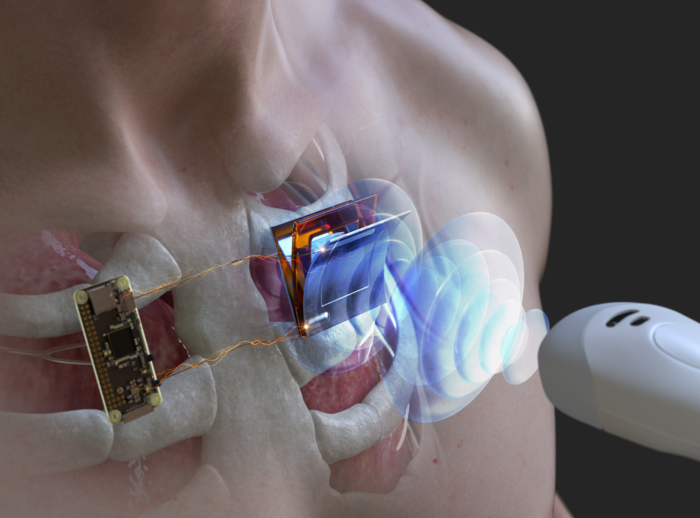Charging underwater and body-implanted electronic devices using ultrasonic waves

Schematic illustration of wirelessly charging a body-implanted electronic device using an ultrasonic probe
Credit: Korea Institute of Science and Technology (KIST)
Improved efficiency of wireless energy transfer of ultrasonic waves by triboelectric power generation. Ultrasonic waves have applications in wireless charging of batteries underwater or in body-implanted electronic devices.
As population ages and with the advancements in medical technology, the number of patients using implanted electronic devices, such as artificial pacemakers and defibrillators, is increasing worldwide. Currently, the batteries of body-implanted devices are replaced by an incision surgery, which may lead to health complications. Accordingly, a new charging technique by wireless energy transfer is emerging that can also be used to charge the batteries of underwater devices, such as sensors, that are used for monitoring the conditions of submarine cables.
The Korea Institute of Science and Technology (KIST, President: Seok-Jin Yoon) announced that a research team led by Dr. Hyun-Cheol Song at the Electronic Materials Research Center developed an ultrasonic wireless power transmission technology that can be applied in the above-mentioned research areas.
Electromagnetic (EM) induction and magnetic resonance can be used in wireless energy transfer. EM induction is presently being used in smartphones and wireless earphones; however, its usage is limited because EM waves cannot pass through water or metal, resulting in short charging distance. In addition, this method cannot be easily used to recharge implanted medical devices as the heat generated during charging is harmful. The magnetic resonance method requires that the resonant frequencies of the magnetic field generator and transmitting device are exactly the same; moreover, a risk of interference with other wireless communication frequencies, such as Wi-Fi and Bluetooth, exists.
The KIST team, therefore, adopted ultrasonic waves as an energy transmission medium, instead of EM waves or magnetic fields. Sonar, which uses ultrasound waves, is commonly used in underwater environments, and the safety of using ultrasonic waves in the human body has been guaranteed in various medical applications, such as organ or fetal condition diagnosis. However, the existing acoustic energy transfer methods are not commercialized easily due to the low transmission efficiency of acoustic energy.
The research team developed a model that receives and converts ultrasonic waves into electrical energy using the triboelectric principle that allows for the conversion of small mechanical vibrations into electrical energy effectively. By adding a ferroelectric material to the triboelectric generator, the ultrasonic energy transfer efficiency was significantly improved from less than 1% to more than 4%. Moreover, charging of more than 8 mW power at a distance of 6 cm was possible, which was sufficient to simultaneously operate 200 LEDs or to communicate Bluetooth sensor data underwater. In addition, the newly developed device had high energy conversion efficiency and generated marginal amounts of heat.
Dr. Song explained the significance of the results as follows: “This study demonstrated that electronic devices can be driven by wireless power charging via ultrasonic waves. If the stability and efficiency of the device are further improved in the future, this technology can be applied to supply power wirelessly to implantable sensors or deep-sea sensors, in which replacing batteries is cumbersome.”
KIST was established in 1966 as the first government-funded research institute to establish a national development strategy based on science and technology and disseminate various industrial technologies to develop major industries. KIST is now raising Korean science and technology status through world-leading innovative research and development. For more information, please visit our website at https://eng.kist.re.kr/kist_eng_renew/
This research was supported the National Research Foundation of Korea (NRF) grant and the National Research Council of Science & Technology (NST) grant funded by the Ministry of Science and ICT (Ministrer: Hye-Sook Lim) and the Korea Institute of Energy Technology Evaluation & Planning (KETEP) grant funded by the Ministry of Trade, Industry and Energy (Minister: Sung Wook Moon). The research results have been published in the latest issue of the “Energy & Environmental Science” (IF: 38.5, top 0.182% in JCR), an renowned international academic journal in the field of energy.
Journal: Energy & Environmental Science
DOI: 10.1039/D1EE02623B
Article Title: Ferroelectrically augmented contact electrification enables efficient acoustic energy transfer through liquid and solid media
Article Publication Date: 22-Jan-2022
All latest news from the category: Medical Engineering
The development of medical equipment, products and technical procedures is characterized by high research and development costs in a variety of fields related to the study of human medicine.
innovations-report provides informative and stimulating reports and articles on topics ranging from imaging processes, cell and tissue techniques, optical techniques, implants, orthopedic aids, clinical and medical office equipment, dialysis systems and x-ray/radiation monitoring devices to endoscopy, ultrasound, surgical techniques, and dental materials.
Newest articles

Innovative 3D printed scaffolds offer new hope for bone healing
Researchers at the Institute for Bioengineering of Catalonia have developed novel 3D printed PLA-CaP scaffolds that promote blood vessel formation, ensuring better healing and regeneration of bone tissue. Bone is…

The surprising role of gut infection in Alzheimer’s disease
ASU- and Banner Alzheimer’s Institute-led study implicates link between a common virus and the disease, which travels from the gut to the brain and may be a target for antiviral…

Molecular gardening: New enzymes discovered for protein modification pruning
How deubiquitinases USP53 and USP54 cleave long polyubiquitin chains and how the former is linked to liver disease in children. Deubiquitinases (DUBs) are enzymes used by cells to trim protein…



